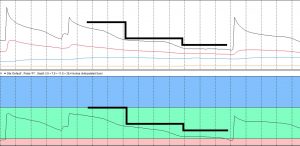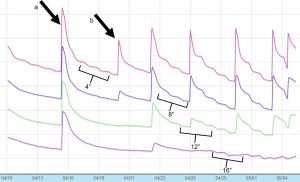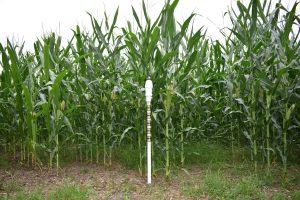Soil moisture sensors are useful for making irrigation decisions, record keeping and monitoring plant roots. Knowing where a crop root zone is or is not helps fine-tune an irrigation schedule. Here is how:
DETERMINING HOW MUCH WATER TO APPLY
An irrigation schedule is a game plan for how a crop will be irrigated. Many Extension programs publish irrigation recommendations based on planting date and crop type. An example from the University of Florida can be found at http://edis.ifas.ufl.edu/ss491.
Whether an irrigation schedule is in use or not, the soil moisture sensor can be checked for trends to determine how current practices are working. With the sensors, the user can see if the soil is drying out or if the soil moisture is increasing over time. For example, if a grower determines current practices are causing the soil to lose more moisture than is being replaced with irrigation, the grower can increase the amount of irrigation to meet crop demand.

Figure 1. Soil moisture sensor output shows what is happening in the soil at various depths (top) and how wet the soil is (bottom).
Figure 1 shows a soil moisture sensor output generated by IrriMAX™ Sentek. In the top graph, the lines represent soil moisture at five depths, 4 to 20 inches below the soil surface in 4-inch increments. The top graph gives the user information on what is happening in the soil at each depth.
The stair-step pattern seen in the center of both graphs is indicative of root water uptake. The stair-step pattern is the result of daytime root activity (soil moisture depletion), and at night there is a flattening off (the plant is not transpiring).
The bottom graph is a sum of the top lines and is a good way to determine the overall direction the soil moisture is headed. The blue, green and red areas indicate if the soil is wet, adequate or dry.
WHEN TO BEGIN IRRIGATING AGAIN AFTER RAIN
Determining when to start irrigating after a rainfall can be difficult in sandy soils common to Florida. This is because water drains quickly in sandy soils, and there is little water-holding capacity. The soil surface can dry out after only a day or two, giving the appearance of very dry conditions when deeper in the soil there could be good moisture. These observations can be made using soil moisture sensors.
Figure 2 shows a soil moisture sensor output generated by AGSPY™. The 2.04-inch rainfall event that happened on April 15, 2018 (arrow a) quickly drained, and the crop required irrigation on April 20, 2018. Notice the large spike in soil moisture at the four depths shown from the rainfall event and compare that to the smaller, 0.48-inch irrigation event (arrow b).

Figure 2. Soil moisture sensors can provide data useful in determining when to irrigate after rainfall.
IRRIGATING TO THE ROOT DEPTH AND NOT BEYOND
The stair-step pattern of the top line between arrows a and b shows the root depth. As the crop progresses, the stair-step root activity can be seen at deeper soil depths, and irrigation was increased to accommodate the root zone of the crop. This is seen on the figure as spikes in moisture to a depth of 12 inches.
GETTING AHEAD, FALLING BEHIND AND CATCHING UP
There is a concern that if not enough irrigation is applied, the grower could fall behind, and the crop will be stressed. This is a more common fear as the crop begins fruiting and as the fruit expands. Early in the season, we can see irrigators getting ahead of the crop, i.e. applying more irrigation than necessary and/or to a depth below the root zone. Catching up can be difficult if the crop is mature and the irrigation capacity was already at its max when the irrigator fell behind.
Much information can be gleaned from soil moisture sensors if your eye is trained to see it. Please contact me at cebarrett@ufl.edu with questions.
Charles Barrett is an Extension agent at the University of Florida Institute of Food and Agricultural Sciences Suwannee Valley Agricultural Extension Center.
This article was featured in the July issue of VSCNews magazine. If you would like to receive future issues of VSCNews magazine, subscribe here.
Share this Post











